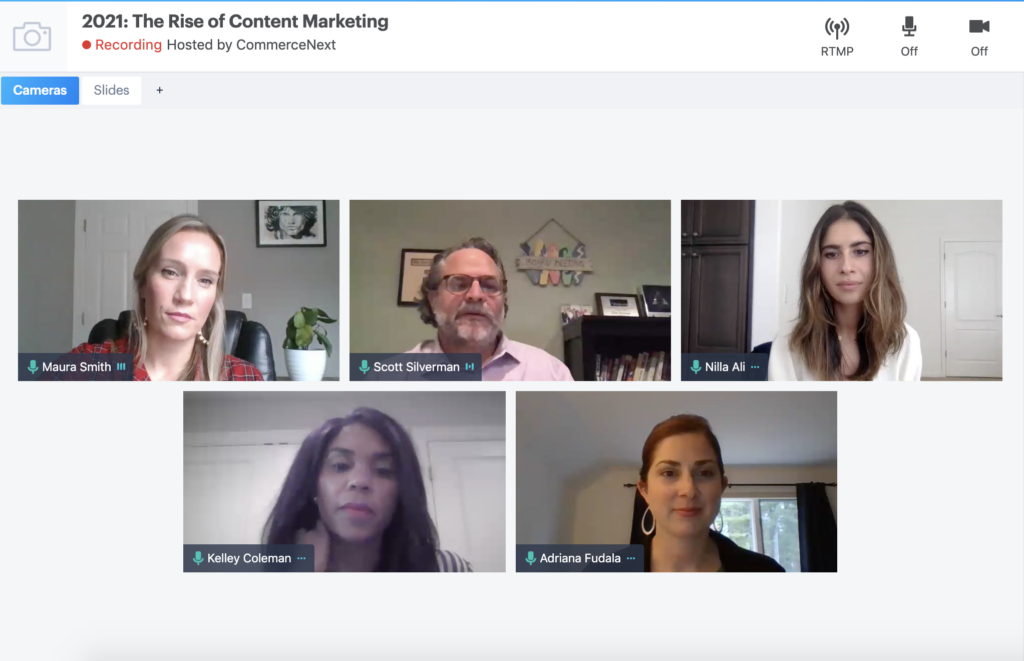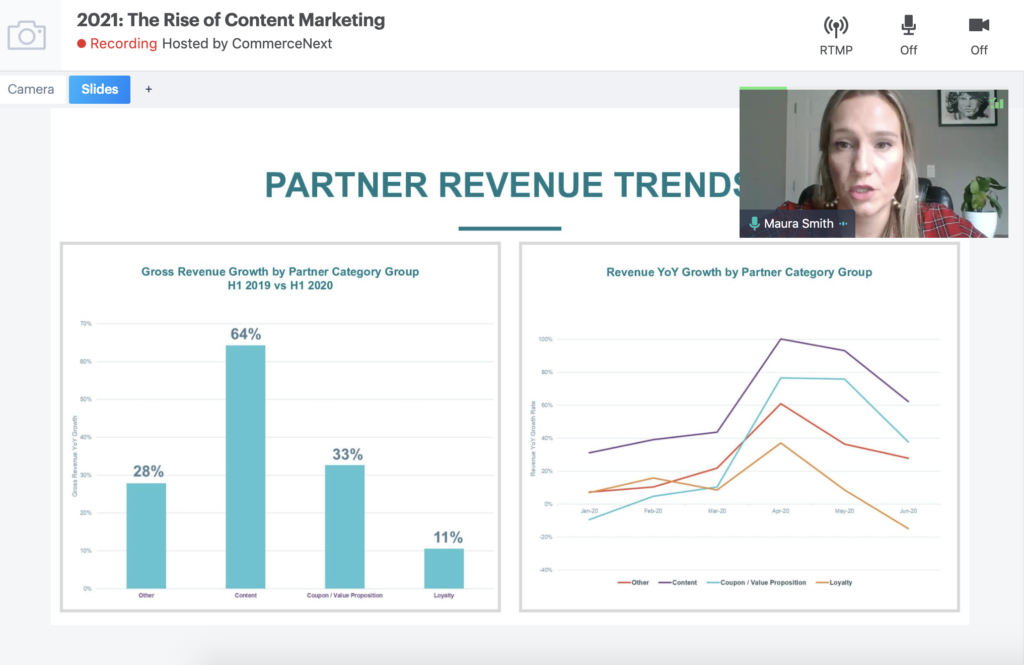The digital landscape of retail and ecommerce has grown immensely over the last year, both due to COVID-19 and other factors in the market. With stay at home orders and quarantines, consumers are occupying the digital space more than ever, and they are requiring a more personal connection to brands. As a result, more and more companies are using content marketing strategies to meet their customer’s needs.
Moderated by our Co-Founder Scott Silverman, our panelists Maura Smith (CMO, Pepperjam), Kelley Coleman (Executive Director, Ecommerce, Tarte Cosmetics), Adriana Fudala (VP, Americas Marketing, Clarks) and Nilla Ali (SVP, Commerce, Buzzfeed) discussed:
- The evolution of content marketing
- Its challenges and opportunities
- How to integrate content marketing into your 2021 marketing strategy

Intro: Content Meets Affiliate
To begin, Smith presented data from Pepperjam to lead us through content’s role in affiliate marketing. Affiliate offers versatility in digital, between display, paid search and other marketing types. The pay for performance model made it very attractive, and affiliate developed as a last click channel. Over time, brands sought out partners that would help drive new customer acquisition, rather than being at the end of the conversion process. Content partners were more often a part of the introductory stages of conversion, but the last click model did not accommodate them.
Pepperjam’s partner category types include:
- Coupon/Value Proposition
- Loyalty
- Content – Influencers and News
- Others – paid search, remarketing publishers
The chart below shows that for partner revenue growth in H1 2020 vs H1 2019, content grew the most, at 64 percent.

Why did this shift happen?
Content partners have increasingly needed new revenue streams to increase income, especially with the pandemic. Loyalty programs have decreased, and brands want to rely on content partners instead of last click partners because of the consistency and newfound ability to succeed with top of funnel acquisition. The conversion rate growth shows that content partners are trustworthy sources for customers.
The data support that content partners drive traffic and increased revenue and provide significant new customer acquisition.
Smith recommends that brands elevate their content in 2021 and move affiliate programs beyond last click. To do this, they should evaluate publisher composition and performance, identify the opportunity with content partners and diversify so that content is a key contributor in the overall mix.
Panel Discussion
The panel covered all things content marketing, but a few major themes arose during the conversation:
Gen Z
There is an emerging Gen Z audience, who is a digitally native audience used to buying things from recommendations online. They need an emotional connection and content is a way to capture their attention. Content can introduce your brand to new consumers and build credibility from other people.
Attribution
The next step in developing content marketing is bridging the gap between attribution for affiliate and other channels. Platforms like Pepperjam allow marketers to export their data and have a holistic view of how affiliate compares to other channels. However, publishers do not have access to this data on their end. Bringing the worlds of brand awareness/sentiment and attribution together will allow more people to lean into the space.
Measuring Success
Knowing how to drive return on ad spend is a necessity, but beyond that, brand sentiment is key. Create a budget to test content space and further develop your content.
Influencers
Content marketing is here to stay, so leaning into influencers and scaling that channel is important. They drive personality-driven content, which is important for younger generations. Testing is required and it can take time to look at different influencers and find what works for your brand. Clarks found that micro/small influencers had great engagement and helped drive traffic for them. Tarte, in the beauty space, found that using unique influencers and bundled products has worked well for them, to complement something that was already in the influencer’s client base. BuzzFeed has a creator program, which uses BuzzFeed influencers who are tapped into the network, solving the scaling problem.
TikTok
TikTok is a space that brands need to be in to connect with Gen Z and younger consumers, but the platform itself needs to mature and create more revenue if brands are going to stay there long term. There is a rise in engagement, but there are not enough conversions coming from the platform yet. There is potential for it to occupy a greater share of affiliate marketing in the future.
Closing: Quick Content Tips
To end the session, each panelist shared a piece of advice for brands planning their 2021 strategies:
- Ali recommends finding publishers/influencers who best align with your target audience and leveraging data in the right way
- Fudala recommends keeping testing! If you don’t nail it on the head the first time, keep going
- Coleman recommends setting your goals, but staying curious and being open to new ideas
- Smith recommends using affiliate content partners – the COVID trend will continue into 2021, so engaging your audience with compelling content will be key
Watch the full session here.
Related Posts
-
Balancing Brand and Performance Marketing At Scale
It seems that these days, every marketing team’s goal is…
-
Connecting Cause Marketing with Brand Mission for Good
Consumers are looking for a cause. Sixty-four percent of consumers…
-
Analyzing the Ecommerce and Digital Marketing Impact of the COVID-19 Pandemic
WITHIN tracks daily revenue, media spend and conversion rates across…




